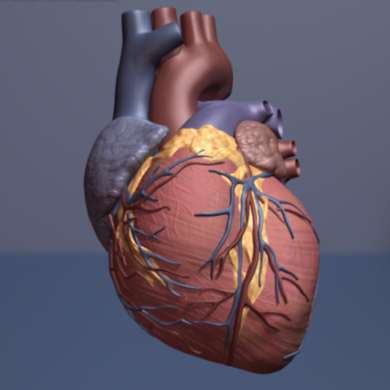This article has been reviewed according to Science X's editorial process and policies. Editors have highlighted the following attributes while ensuring the content's credibility:
fact-checked
peer-reviewed publication
trusted source
proofread
First international guidelines on heart muscle diseases published

The European Society of Cardiology (ESC) Guidelines on cardiomyopathies are published online today in European Heart Journal. This is the first international guideline document to include all cardiomyopathy subtypes, and the first time that specific recommendations are made for cardiomyopathies other than hypertrophic cardiomyopathy.
"This pioneering document reflects the advances in genetics and cardiac imaging and the advent of new treatments that target specific causes of disease," said Guidelines task force chairperson Dr. Elena Arbelo of the Hospital Clinic, University of Barcelona, Spain.
"At the core of this new Guideline are patients and their families, starting from the point at which an individual presents with symptoms, or as an incidental finding or because of a family history, and working through the pathway towards making a diagnosis and starting treatment," said Guidelines task force chairperson Dr. Juan Pablo Kaski of University College London, UK.
Cardiomyopathies are conditions that affect the muscle of the heart. They are a group of conditions that can affect the heart's structure, reduce its ability to pump blood around the body and cause abnormal heart rhythms. Cardiomyopathies can present at any age and affect patients and families across the life course. They are often caused by changes in the genes responsible for how the heart muscle cells function, meaning that they can run in families.
Overall, cardiomyopathies are relatively common, affecting around 1 in every 250 people. Some cardiomyopathies are more common than others, however, and the risks and complications are also variable. Many people have very few, if any, symptoms, but others experience fatigue, shortness of breath, chest pain, palpitations and fainting, and have complications such as stroke or sudden death.
The guidelines highlight the many areas of diagnosis and management that are shared across cardiomyopathy subtypes and gives specific recommendations for each. Diagnosis starts with a description of how the heart looks and behaves—is it thickened, dilated or scarred, and is the pumping function abnormal?—and then incorporates information on heart rhythm abnormalities, family history and genetic testing to arrive at a more precise diagnosis. Cardiomyopathy should be considered as the potential cause of other conditions such as heart failure.
"Imaging techniques including echocardiography and cardiac magnetic resonance imaging are essential for the diagnosis of certain subtypes and can help identify patients at risk of sudden death," said Dr. Arbelo.
The diagnosis of an inherited cardiomyopathy may lead to exclusion from competitive sports and affect decisions about having children. Some patients must live with a small risk of sudden death or the possibility of a future heart transplantation. An implantable cardioverter defibrillator (ICD) may be advised to prevent sudden death.
The guidelines recommend genetic counseling to support patients and their relatives understand and adapt to the diagnosis of a genetic disease. It should be offered before a decision to test is made and when the results are returned to the patient and their family. In addition, clinical psychological support should be offered to all patients who have undergone ICD implantation or who have a family history of sudden cardiac death.
For all cardiomyopathies, management aims to identify and treat symptoms, prevent complications and screen at-risk relatives. Identifying those at increased risk of sudden death is a major focus of these guidelines. Shared decision-making is advised when selecting certain treatments such as ICDs. Other treatments include drugs to address symptoms and heart transplantation.
Many subtypes are inherited in an autosomal dominant way, meaning that offspring have a 50% chance of inheriting the mutation. When such a mutation is found, testing of relatives can be considered. Dr. Kaski said, "Early diagnosis and treatment of family members can prevent disease progression in some cardiomyopathies and avoid complications."
A dedicated section of the guidelines provides advice for patients on living with a cardiomyopathy. This includes exercise, diet, alcohol, weight, reproductive issues, sexual activity, medication, vaccination, driving, employment, holidays and travel insurance, and life insurance.
Cardiomyopathies are the leading cause of exercise-related sudden cardiac death in young people in the Western world. In some cardiomyopathies, exercise accelerates progression of the disease, and this has historically resulted in recommendations for all patients to limit activity. Many patients have confined themselves to a relatively sedentary lifestyle through fear of sudden cardiac death and have missed out on the benefits of exercise in preventing coronary artery disease.
These guidelines recommend regular low to moderate intensity exercise for all patients with cardiomyopathy who are able to do so. An individualized risk assessment should be performed so that an exercise prescription can be provided taking into account the prevention of life-threatening arrhythmias during exercise, symptom management to allow sports and preventing sports-induced progression of the disease. Patients with certain cardiomyopathies should avoid very high intensity or competitive sports.
The guidelines recommend a multidisciplinary approach to patient care, and timely and adequate preparation for transition of care from pediatric to adult cardiomyopathy services. They emphasize the need for integrated care between specialist cardiomyopathy teams and other professionals, including cardiologists, geneticists, genetic counselors, pathologists and other specialties, as well as close interactions between primary, secondary and tertiary care.
More information: Elena Arbelo et al, 2023 ESC Guidelines for the management of cardiomyopathies, European Heart Journal (2023). DOI: 10.1093/eurheartj/ehad194




















